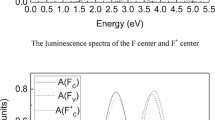Abstract
We report on the first principle density functional calculation of the charge transition levels of native defects (vacancies and interstitials) in CaF2 structure. The transition level was defined as the Fermi level where two charge states of given defect have the same formation energy. The common error in the band gap inherited to semiclocal density functional has been accounted for by incorporating the hybrid density functional method, leading to correct placement of the transition levels within the band gap. The band gap size from hybrid calculation has been validated using the full potential, Linearized Augmented Planewave method with the Modified-Becke-Johnson exchange potential. Prior to level calculations, we ensured that an agreement between the formation energies from small (95–97 atoms) and large (323–325 atoms) supercells was achieved after applying the Makov-Payne correction method. Our calculated transition level for the anion vacancy was 2.97 eV below the conduction band, agreeing with the experimental optical absorption band at 3.3 eV associated with the electron transition from the ground state F-center to the conduction band in CaF2.
Similar content being viewed by others
References
A. Puchina et al., Solid State Commun. 106, 285 (1998)
M. Verstraete, X. Gonze, Phys. Rev. B 68, 195123 (2003)
G.W. Rubloff, Phys. Rev. B 5, 662 (1972)
K. Sun et al., J. Mater. Sci.: Mater. Electron. 26, 4438 (2015)
L. Dressler, R. Rauch, R. Reimann, Crystal Res. Technol. 27, 413 (1992)
Y. Shimizu et al., Phys. Lett. B 633, 195 (2006)
H. Shi, R. Jia, R. Eglitis, Comput. Mater. Sci. 89, 247 (2014)
H. Shi et al., J. Phys. Chem. C 116, 4832 (2012)
J.P. Perdew, K. Burke, M. Ernzerhof, Phys. Rev. Lett. 77, 3865 (1996)
A. Alkauskas, P. Broqvist, A. Pasquarello, Phys. Rev. Lett. 101, 046405 (2008)
J.P. Perdew, M. Ernzerhof, K. Burke, J. Chem. Phys. 105, 9982 (1996)
F. Tran, P. Blaha, Phys. Rev. Lett. 102, 226401 (2009)
P. Blaha et al., Wien2k. An augmented plane wave + local orbitals program for calculating crystal properties, 2001
P. Giannozzi et al., J. Phys.: Condens. Matter 21, 395502 (2009)
D. Vanderbilt, Phys. Rev. B 41, 7892 (1990)
C. Freysoldt et al., Rev. Mod. Phys. 86, 253 (2014)
M. Leslie, N. Gillan, J. Phys. C 18, 973 (1985)
G. Makov, M. Payne, Phys. Rev. B 51, 4014 (1995)
C. Castleton, A. Höglund, S. Mirbt, Modell. Simul. Mater. Sci. Eng. 17, 084003 (2009)
D.A. Drabold, S.K. Estreicher, Theory of defects in semiconductors (Springer, 2007)
C. Gaire et al., Nanotechnology 21, 445701 (2010)
J.R. Reimers, Computational methods for large systems: electronic structure approaches for biotechnology and nanotechnology (John Wiley & Sons, 2011)
F. Murnaghan, Proc. Natl. Acad. Sci. 30, 244 (1944)
A. Tressaud, Functionalized inorganic fluorides: synthesis, characterization and properties of nanostructured solids (John Wiley & Sons, 2010)
P.W.O. Nyawere et al., Solid State Commun. 179, 25 (2014)
A.D. Becke, J. Chem. Phys. 98, 1372 (1993)
M. Topsakal, R. Wentzcovitch, Comput. Mater. Sci. 95, 263 (2014)
C.G. Van de Walle, J. Neugebauer, J. Appl. Phys. 95, 3851 (2004)
A. Seidl et al., Phys. Rev. B 53, 3764 (1996)
S. Lany, A. Zunger, Phys. Rev. B 78, 235104 (2008)
H. Shi, R. Eglitis, G. Borstel, Phys. Rev. B 72, 045109 (2005)
Author information
Authors and Affiliations
Corresponding author
Rights and permissions
About this article
Cite this article
Ibraheem, A.M., Khalafalla, M.A. & Eisa, M.H. First principle calculation of accurate native defect levels in CaF2 . Eur. Phys. J. B 90, 42 (2017). https://doi.org/10.1140/epjb/e2017-70591-0
Received:
Revised:
Published:
DOI: https://doi.org/10.1140/epjb/e2017-70591-0



